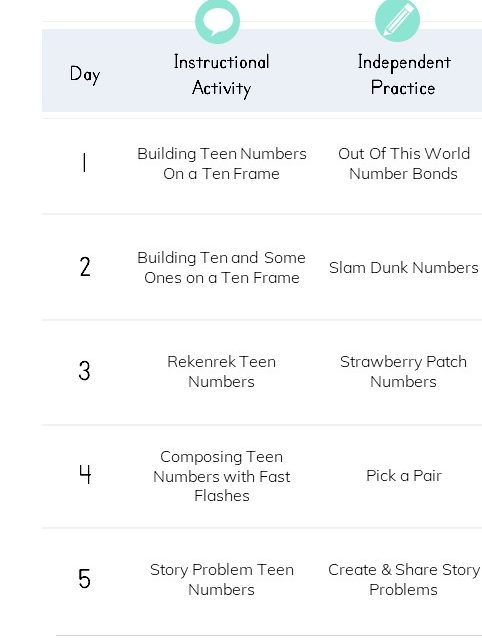This post contains affiliate links. This means that when you make a purchase, at no additional cost to you, I will earn a small commission.
If, for whatever reason, math intervention is feeling overwhelming right now, this blog post is for you. These quick-start math intervention resources will help you move from no-plan to ready-to-go in a few short and simple steps.

When a project feels too big or too overwhelming it can be easy to move it to the back burner. So we’re stripping math intervention down to the absolute basics with math intervention resources you can use to plan and be ready for a group as early as tomorrow.
Step 1: Pick a Topic
We’re talking QUICK START here so I’m not going to ask you to dive deep into multiple data points. When creating a long-term plan that’s what I would advocate but, for right now, we’re going to start small with one single topic that we can tackle that will have a positive impact on your students.
Look back at the last assessment you gave in your classroom. This may be a unit assessment or might even be as small as an exit ticket you gave at the end of a recent lesson.
Look for trends. Is there a question or topic that multiple students struggled with? This might be a great starting point.
As you pinpoint your topic, continue to ask yourself “why” your students struggled with that question. This will ensure that you don’t choose a topic that is too large and will also ensure that you are teaching to the root of the problem rather than putting a bandaid on a misconception.
Step 2: Choose Your Group
Now that you know the topic you will be targeting, look at your students and select those that would be good candidates for this intervention group. This step will likely go hand-in-hand with step 1 as these students will surface as you are examining your assessments and choosing a topic but it is important to document the students that you are selecting.
Provide a pre-assessment of the skill for these students. This can be a very short assessment and doesn’t have to be anything fancy! You can write a few questions up on a dry-erase board (Take a picture of your questions if you go this route– more on that later!) and observe your students as they solve 4-5 problems. This will provide you with a baseline to measure growth by and also will provide more information about the misconceptions your students may have and *why* they are not yet successful on this skill.
Step 3: Plan Your Math Intervention Resources
You’ll want to create a pathway from where you students are to where you want them to be. A simple way to create this pathway is to “Think CRA“. In a nutshell, this means that you will start by asking yourself:
- How can I provide an experience that allows my students to practice this skill using hands-on materials?
- Is there another hands-on material I can use so that my students have multiple experiences with hands-on tools?
- How can I provide a representational (drawings or models) experience for my students so that we can eventually take away the hands-on support?
- What will it look like when my students have reached proficiency at this skill? What lessons and experiences can I create for my students that will allow them to practice at this abstract level?

In this example, students will follow a 5-day pathway to understand teen numbers.
On day 1, students are building teen numbers on a double ten frame. (Hands-On)
On day 2, students continue with the double ten frame but the first ten are filled in for them- this extends students’ understanding from teen numbers as a group of ones to teen numbers as a ten and some ones.
Next, students work with a new hands-on material on day 3. Students build and identify teen numbers on a rekrenrek.
On day 4, students move away from hands-on materials and look at pictures of a ten and some ones to quickly identify teen numbers.
Finally, on day 5, students solve story problems involving a ten and some ones to identify teen numbers.
Step 4 (Optional): Plan for Practice
The purpose of this quick-start guide is to build your momentum working with students to provide math intervention. If you have identified a skill and students who need to work on that skill, and if you have planned a quick pathway for your students to work through from hands-on to abstract you are well ahead of the game. You will absolutely see progress in your students doing just these simple things.
To support your students in their independence with these skills, add in step four; plan for practice. For each step on your pathway, add an independent activity so that your students can build independence in that skill. Create independent practice activities that directly mirror your lesson. If your students were working with base ten blocks during your small group lesson, create an independent practice that requires the use of base ten blocks. If your independent practice featured a place value chart, your independent practice activity will use exactly the same model.
Step 5: Post Assessment
Back in step 2, you conducted a pre-assessment of your target skill. Now that you have reached the end of your instruction, give your students exactly the same assessment with only the numbers changed. You are looking for growth on this skill to confirm that your students are ready to progress to another skill. This assessment is also important when it comes to report cards, progress notes or student data meetings. You can easily show growth (or, lack of growth) between the pre and post assessment based on a systematic intervention.
Step 6: Put It In Your Planner
You now have a skill, a group of students, lessons, and assessments- you have everything you need to support your students- but it won’t work unless you ensure that you are putting these math intervention resources to work! Plan for 20-30 minutes every other day for 2 weeks. This is truly only 5 or 6 sessions but it will make such a difference in your student’s success!
This will also allow you to gauge whether or not this is a time you can commit to long-term as a math intervention block.
Step 7: Grab Your Math Intervention Resources and Get Started!
I have two options to get you started.
Option 1: Sign Up Here for the Math Intervention Quick Start Guide. This is a one-sheet planner you can use to move through the steps in this blog post.
Option 2: If you are in need of “done for you” math intervention, I have 43 individual 5-lesson units spanning from late kindergarten through 3rd-grade math standards. You choose the skill and the students and I’ll provide the assessments, lessons and independent practice. Jumping back into math intervention can not be more simple than these units!




